5 Types of Forex Charts and How to Read Them
Learn about the 5 types of Forex charts and how to read them effectively. Master candlestick, line, bar, and other charts to make informed trading decisions and improve your Forex trading strategies.

When it comes to Forex trading, understanding Forex charts is essential for making informed decisions. These charts are used to analyze past market data and predict future price movements. They come in various forms, and each provides different insights into market trends, helping traders make smarter decisions.
We will explore the different types of Forex charts and explain how to read them effectively.
Line Charts
Line charts are the most basic type of chart used in Forex trading. They display a simple line that connects the closing prices of a currency pair over a set period of time. This type of chart is excellent for beginners, as it offers a clear, straightforward representation of price movement.
How to Read Line Charts:
- The x-axis represents time (e.g., minutes, hours, days).
- The y-axis represents price levels.
- The line shows the closing price for each time period.
While line charts are simple to interpret, they lack the depth and detail that more advanced charts provide. However, they are still useful for tracking overall price movement and identifying trends over a long period.
Bar Charts
Bar charts provide more detailed information compared to line charts. Each bar on the chart represents a specific time period and includes four key price points: the open, high, low, and close (OHLC). Bar charts help traders see price ranges and market volatility more clearly.
How to Read Bar Charts:
- The vertical bar shows the range of prices for a given period.
- The horizontal tick on the left indicates the opening price.
- The horizontal tick on the right shows the closing price.
- The top and bottom of the bar represent the highest and lowest prices during that time frame.
Bar charts are more detailed than line charts and offer insights into market volatility, but they may take a little longer to read for beginners.
Candlestick Charts
Candlestick charts are by far the most popular charting method used by Forex traders due to their ease of use and the wealth of information they provide. A candlestick consists of a body and two "wicks" or "shadows" that show the high and low prices for a specific period.
How to Read Candlestick Charts:
- The body of the candle represents the opening and closing prices.
- If the close price is higher than the open price, the body is typically green or white (bullish).
- If the close price is lower than the open price, the body is red or black (bearish).
- The wick represents the highest and lowest prices during that time period.
- Traders use candlestick patterns (e.g., Doji, Hammer, Engulfing) to predict future market movements.
Candlestick charts are extremely useful for spotting trends, reversals, and market sentiment, making them a favorite among traders.
Point and Figure Charts
Point and figure charts are quite different from other chart types because they do not use time as a factor. Instead, these charts focus purely on price movements, filtering out minor fluctuations. X's and O's are used to represent price movements: X's for upward movements and O's for downward movements.
How to Read Point and Figure Charts:
- The chart is created using X's (for price increases) and O's (for price decreases).
- The chart does not account for time or minor price changes but focuses on larger price moves.
- This type of chart helps traders identify long-term trends and major price shifts.
Point and figure charts are useful for traders who want to eliminate market noise and focus solely on significant price movements.
Renko Charts
Renko charts are another non-time-based chart. They are used to identify trends by filtering out minor price movements. Each "brick" or "block" represents a predefined price movement, and new bricks are only added once the price moves by a specified amount.
How to Read Renko Charts:
- Each brick is placed in the direction of the trend, and a new brick appears when the price moves by a specific value.
- Renko charts help identify trends more clearly by removing short-term price fluctuations.
- These charts are best used for spotting long-term trends and potential reversals.
Renko charts are particularly popular among trend-following traders who prefer a clearer view of price action without the distraction of market noise.
Conclusion:
Each type of Forex chart provides a unique perspective on price action and market trends. Understanding how to read these charts is crucial for making informed decisions and developing a successful trading strategy. Whether you prefer the simplicity of line charts, the detailed analysis of bar and candlestick charts, or the trend-focused approach of point and figure and Renko charts, mastering these tools will help you navigate the Forex market more effectively.
If you're looking for a trading platform that offers comprehensive charting tools and features, GoDoCM is a great choice. The GoDoCM platform provides advanced charting capabilities, including candlestick, bar, and other chart types, to help you analyze the market and execute your trades with precision. For more insights on its features, be sure to check out a GoDoCM Review to see how it can enhance your trading experience.
What's Your Reaction?















